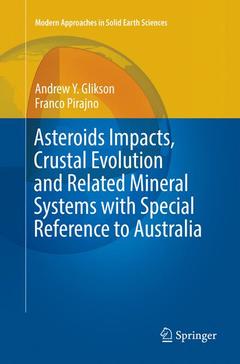Asteroids Impacts, Crustal Evolution and Related Mineral Systems with Special Reference to Australia, Softcover reprint of the original 1st ed. 2018 Modern Approaches in Solid Earth Sciences Series, Vol. 14
Auteurs : Glikson Andrew Y., Pirajno Franco

Introduction:
II. Asteroid impacts in time and space
III. Criteria for identification of asteroid impact events
IV. Asteroid impacts in time
IV.1 Archean asteroid impacts
IV.1.1 ~3.46-3.47 Ga bombardment
IV.1.1.1 Miralga Creek impacts (~3.47 Ga)
IV.1.1.2 Marble Bar impacts (~3.46 Ga)
IV.1.2 ~3.22-3.25 Ga bombardment
IV.1.2.1 Sulphur Springs unconformities and olistostrome (~3.22 Ga)
IV.1.3 ~2.63-2.48 Ga bombardment
IV.1.2.2 Jeerinah Impact layer and Carawine tsunami breccia (~2.63 Ga)
IV.1.2.3 Paraburdoo spherule layer (~2.57 Ga)
IV.1.2.4 Spherule Marker Bed (~2.56 Ga)
IV.1.2.5 Dales Gorge Spherule layer (~2.48 Ga)
IV.2 Proterozoic asteroid impacts
IV.3 Phanerozoic asteroid impacts
V. Australian Asteroid impacts
V.1 Exposed impact structures >10 km in diameter
V.1.1 Acraman (~40-90 km)
V.1.2 Yarrabubba (~30-70 km)
V.1.3 Shoemaker (~29-31 km)
V.1.4 Lawn Hill (~18 km)
V.1.5 Strangways (~25-40 km)
V.1.6 Amelia Creek (~20x12 km)
V.1.7 Cleanskin (~15 km)
V.1.8 Glikson (~14 km)
V.1.9 Gosses Bluff (~12 km)
V.1.10 Kelly West (~8-20 km)
V.1.11 Spider (~11-13 km)
V.1.12 Goyder (~9-12 km)
V.1.13 Impact structures <10 km in diameter
V.2 Buried asteroid impacts
V.2.1 Warburton East (~200 km)
V.2.2 Warburton West (~200 km)
V.2.3 Woodleigh (~120 km)
V.2.4 Talundilly (84 km)
V.2.4 Gnargoo (~75 km)
V.2.5 Tookoonooka (~55 km)
V.2.6 Mount Ashmore (>50 km)
V.2.7 Coompana (~44 km)
V.2.6 Yallalie (~12 km)
V.2.7 Lake Raeside (~11 km)
V.3 Meteorite impact craters
V.3.1 Goat Paddock (~6 km)
V.3.2 Liverpool (~1.6 km)
V.3.3 Darwin (~1.2 km
V.3.4 Wolfe Creek (~0.88 km))
V.3.5 Hickman (0.36 km)
V.3.6 Boxhole (0.17 km)
V.3.7 Henbury craters
V.3.8 Other impact craters
V.4 Magnetic and gravity signatures of buried asteroid impact structures
VI. Asteroid impacts and ore genesis
VI.1 A global perspective
VI.2 Australian impact structures associated with mineralization
VII. Asteroids and crustal evolution
Offers a comprehensive account of the Australian asteroids impacts record
Constitutes in part as an Atlas of Australian impact structures and ejecta units
Includes a chapter on Astroid Impacts and crustal evolution
Date de parution : 12-2018
Ouvrage de 215 p.
15.5x23.5 cm
Disponible chez l'éditeur (délai d'approvisionnement : 15 jours).
Prix indicatif 147,69 €
Ajouter au panierDate de parution : 03-2018
Ouvrage de 215 p.
15.5x23.5 cm
Disponible chez l'éditeur (délai d'approvisionnement : 15 jours).
Prix indicatif 147,69 €
Ajouter au panier


